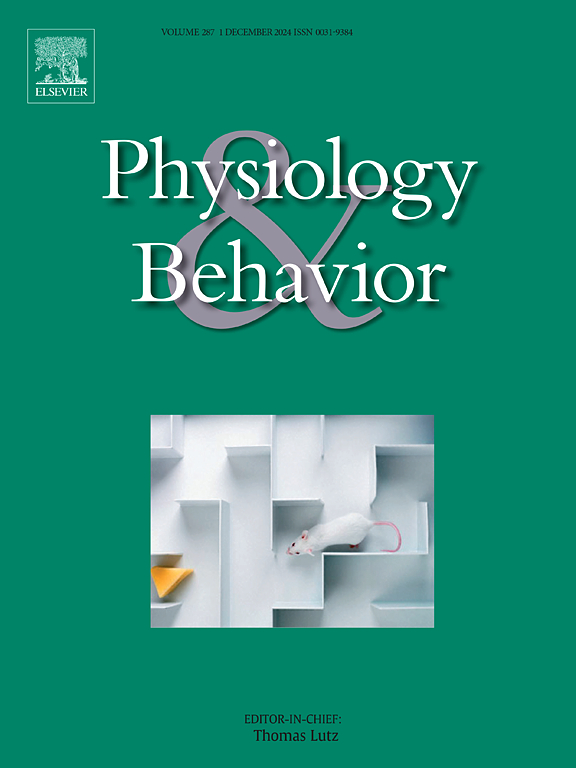Epigenetic regulation of miR-211 in the hypothalamic arcuate nucleus of female rats during diet-induced obesity and caloric restriction
IF 2.5
3区 医学
Q2 BEHAVIORAL SCIENCES
引用次数: 0
Abstract
Epigenetic modifications dynamically regulate gene expression in response to environmental factors. miR-211 has been implicated in hypothalamic regulation of energy homeostasis. This study investigates the epigenetic regulation of miR-211 in the arcuate nucleus (ARC) of female Wistar rats during diet-induced obesity (DIO) and caloric restriction (CR).
Female Wistar rats were subjected to a DIO protocol followed by CR. miR-211 expression was measured in the ARC, and two epigenetic layers—histone methylation (H3K9me2 enrichment) and CpG DNA methylation—were analyzed at the miR-211 promoter. Aml1/Runx1 binding was assessed via chromatin immunoprecipitation.
DIO upregulated miR-211 expression in the ARC, while CR restored it to baseline levels. Increased H3K9me2 enrichment at the miR-211 promoter during DIO was reversed by CR. CpG methylation analysis revealed hypermethylation at the miR-211 promoter, particularly at -78 CpG, during DIO, which partially reverted after CR. Hypermethylation in DIO was associated with reduced Aml1/Runx1 binding, suggesting a loss of transcriptional repression. Blood samples showed a similar CpG methylation pattern, indicating potential biomarker applications.
In conclusion, miR-211 expression in the ARC is regulated by histone and DNA methylation in response to metabolic status. The reversal of these epigenetic changes by CR highlights the potential of lifestyle interventions to mitigate obesity-induced molecular alterations. These findings provide insights into miR-211′s role in hypothalamic dysregulation and its potential as a therapeutic target for obesity management.
饮食诱导肥胖和热量限制期间雌性大鼠下丘脑弓状核miR-211的表观遗传调控。
表观遗传修饰动态调节基因表达以响应环境因素。miR-211与下丘脑的能量稳态调节有关。本研究探讨了雌性Wistar大鼠在饮食诱导肥胖(DIO)和热量限制(CR)过程中,miR-211在弓状核(ARC)中的表观遗传调控。雌性Wistar大鼠接受DIO方案,然后进行cr。在ARC中测量miR-211表达,并分析miR-211启动子处的两个表观遗传层-组蛋白甲基化(H3K9me2富集)和CpG DNA甲基化。通过染色质免疫沉淀评估Aml1/Runx1结合。DIO上调了ARC中miR-211的表达,而CR将其恢复到基线水平。在DIO期间,miR-211启动子的H3K9me2富集被CR逆转。CpG甲基化分析显示,在DIO期间,miR-211启动子的高甲基化,特别是-78 CpG,在CR后部分恢复。DIO中的超甲基化与Aml1/Runx1结合减少有关,表明转录抑制的丧失。血液样本显示出类似的CpG甲基化模式,表明潜在的生物标志物应用。总之,miR-211在ARC中的表达受组蛋白和DNA甲基化调节,以响应代谢状态。CR对这些表观遗传变化的逆转强调了生活方式干预减轻肥胖诱导的分子改变的潜力。这些发现为miR-211在下丘脑失调中的作用及其作为肥胖治疗靶点的潜力提供了见解。
本文章由计算机程序翻译,如有差异,请以英文原文为准。
求助全文
约1分钟内获得全文
求助全文
来源期刊

Physiology & Behavior
医学-行为科学
CiteScore
5.70
自引率
3.40%
发文量
274
审稿时长
47 days
期刊介绍:
Physiology & Behavior is aimed at the causal physiological mechanisms of behavior and its modulation by environmental factors. The journal invites original reports in the broad area of behavioral and cognitive neuroscience, in which at least one variable is physiological and the primary emphasis and theoretical context are behavioral. The range of subjects includes behavioral neuroendocrinology, psychoneuroimmunology, learning and memory, ingestion, social behavior, and studies related to the mechanisms of psychopathology. Contemporary reviews and theoretical articles are welcomed and the Editors invite such proposals from interested authors.
 求助内容:
求助内容: 应助结果提醒方式:
应助结果提醒方式:


